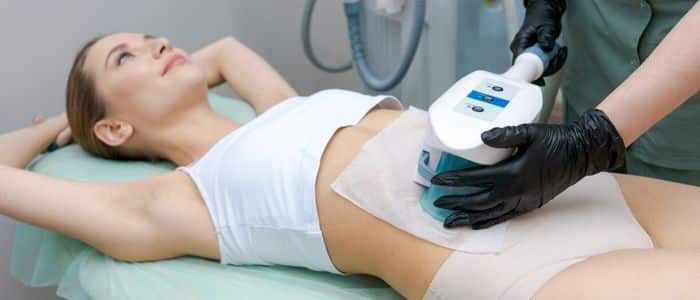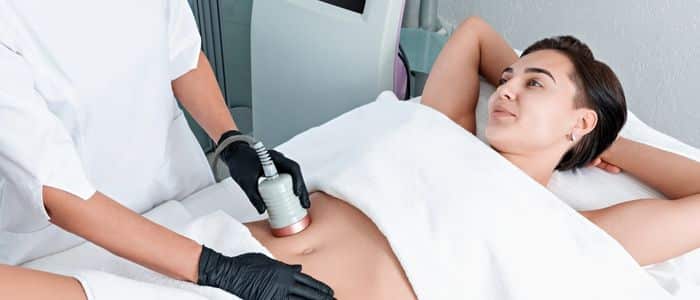
Table of Contents
- How to Choose the Best Non-Surgical Fat Removal Treatment for You
- What Is Non-Surgical Fat Removal?
- Popular Non-Surgical Fat Removal Treatments
- CoolSculpting
- Ultrasonic Cavitation
- Laser Lipolysis
- Radiofrequency Lipolysis
- Aqualyx Fat Dissolving Injections
- Factors to Consider When Choosing a Treatment
- Consultation for Non-Surgical Fat Removal Treatment
- Questions to ask during your consultation
- Non-surgical Fat Removal Treatments Aftercare and Maintenance
- FAQs about Non-Surgical Fat Removal Procedures
- Further Reading about Body Procedures with Consultant Plastic Surgeon Anca Breahna
How to Choose the Best Non-Surgical Fat Removal Treatment for You
In recent years, the allure of achieving a sculpted physique without going under the knife has seen a significant surge in popularity. Non-surgical fat removal treatments offer a promising alternative to traditional surgical methods, allowing individuals to enhance their contours with minimal downtime. As the cosmetic industry continues to evolve, it’s important to understand these treatments and select the one that aligns perfectly with your unique needs.
In this blog, Chester Consultant Plastic Surgeon Anca Breahna aims to shed light on the world of non-surgical fat removal and help you make an informed decision.
What Is Non-Surgical Fat Removal?
Non-surgical fat removal refers to a range of cosmetic procedures designed to reduce or eliminate unwanted fat deposits without the need for invasive surgery. These treatments utilise various technologies, from cooling techniques to ultrasound energy, to target and break down fat cells, which are then naturally eliminated from the body.
Opting for non-surgical methods comes with many advantages. Firstly, there’s no need for incisions, meaning no scars and a significantly reduced risk of infection. The recovery time is much shorter, with most individuals resuming their daily activities almost immediately. Additionally, these treatments tend to be less painful and can be tailored to address specific areas of concern, offering a more personalised approach.
Non-surgical fat removal can be employed on various parts of the body. Popular areas include the abdomen, love handles, thighs, upper arms, chin, and back. The versatility of these treatments ensures that individuals can target multiple areas to achieve a harmonious and well-proportioned silhouette.
Popular Non-Surgical Fat Removal Treatments
The cosmetic industry is teeming with innovative treatments designed to help individuals achieve their desired body contours without resorting to surgery. As technology advances, the options available have expanded, each with its unique approach and benefits. Let’s explore some of the most sought-after non-surgical fat removal treatments available today:
CoolSculpting
- How it works: CoolSculpting, also known as cryolipolysis, harnesses the power of controlled cooling to target and freeze fat cells beneath the skin. Once the fat cells are frozen, they undergo a natural death and are gradually eliminated by the body over the following weeks. The surrounding tissues remain unaffected, making it a precise and effective treatment
- Ideal candidates: Those with stubborn pockets of fat that resist diet and exercise are prime candidates for CoolSculpting. It’s essential to note that this treatment isn’t a weight loss solution but rather a body contouring method
- Pros and cons: One of the primary advantages of CoolSculpting is its non-invasive nature, meaning no needles, anaesthesia, or downtime. Results are long-lasting, as the treated fat cells are permanently removed. However, some individuals might experience temporary redness, swelling, or a tugging sensation during the procedure
Ultrasonic Cavitation
- How it works: Ultrasonic cavitation employs high-frequency sound waves to create micro-bubbles within the fat cells, causing them to burst. The released fat is then metabolised by the liver and excreted naturally
- Ideal candidates: This treatment is suitable for those looking to reduce circumference and cellulite in specific areas. It’s particularly effective on the thighs, abdomen, and flanks
- Pros and cons: Ultrasonic cavitation is painless and can lead to visible results after just a few sessions. It also promotes collagen production, leading to firmer skin. On the downside, multiple sessions might be required for optimal results, and there’s a slight risk of burns if not performed correctly
Laser Lipolysis
- How it works: Laser lipolysis uses targeted laser energy to heat and liquefy fat cells. Once the cells are disrupted, they release their fatty contents, which are then naturally processed and eliminated by the body
- Ideal candidates: Those with smaller areas of stubborn fat, such as the chin or bra line, might find laser lipolysis especially beneficial. It’s also effective in tightening the skin, making it a dual-purpose treatment
- Pros and cons: One of the standout benefits of laser lipolysis is its ability to stimulate collagen production, leading to tighter, more youthful-looking skin. The procedure is relatively quick, often taking less than an hour. However, some individuals might experience mild discomfort during the treatment, and there’s a slight risk of burns or scarring if not done correctly
Radiofrequency Lipolysis
- How it works: Radiofrequency lipolysis utilises radiofrequency energy to heat the deeper layers of the skin, causing the fat cells to break down while simultaneously stimulating collagen production
- Ideal candidates: This treatment is ideal for those looking to address both excess fat and skin laxity. Common treatment areas include the face, neck, abdomen, and thighs
- Pros and cons: Radiofrequency lipolysis offers the dual benefit of fat reduction and skin tightening in a single session. It’s non-invasive and usually pain-free. Multiple sessions might be required to achieve the desired results, and there’s a potential for temporary redness or swelling post-treatment.
Aqualyx Fat Dissolving Injections
- How it works: Aqualyx is a solution that is injected into stubborn fat pockets, causing the dissolution of fat cells. Once the cells are broken down, they release their fatty contents, which are then naturally processed and eliminated by the body
- Ideal candidates: Aqualyx is suitable for individuals looking to reduce localised areas of fat on both the face and body. During a pre-treatment consultation, an in-depth examination will determine the suitability of this treatment for the individual. It’s designed to help achieve a slimmer appearance in targeted areas
- Pros and cons: Aqualyx offers a targeted approach to fat reduction, allowing for precise contouring. The treatment is considered safe and can complement other weight loss efforts, helping to refine and complete one’s body transformation journey. Lidocaine, a mild anaesthesia, can be added to Aqualyx to make the treatment process more comfortable. Post-treatment, there might be tenderness, slight swelling, and bruising in the treated area. However, these side effects usually last for only about a week. Multiple sessions might be required for optimal results, with 2-3 procedures often recommended. It may take up to 6 weeks for the fat cells to be broken down and expelled from the body. If a course of treatments has been advised, the final results will be noticeable approximately 6 weeks after the last session
Factors to Consider When Choosing a Treatment

Selecting the right non-surgical fat removal treatment is a decision that should be made with careful consideration. Various factors can influence your choice, ensuring that the selected treatment aligns with your goals and circumstances. Here are some essential aspects to ponder:
- Your goals and expectations
Begin by clearly defining what you hope to achieve with the treatment. Are you looking for subtle changes, or do you desire a more dramatic transformation? Understanding your goals will help you and your practitioner determine the most suitable treatment for you.
- The area(s) you want to treat
Different treatments might be more effective for specific body parts. For instance, while CoolSculpting might be ideal for larger areas like the abdomen, Aqualyx injections could be more suited for smaller, localised fat pockets.
- Your budget
Non-surgical fat removal treatments can vary in cost. It’s essential to have a clear budget in mind and discuss this with your practitioner. Some treatments might require multiple sessions, which can influence the overall cost.
- Potential side effects and recovery time
While non-surgical treatments generally have minimal downtime, some might lead to temporary side effects like swelling or bruising. Consider your schedule and any upcoming events when choosing a treatment, ensuring you have ample recovery time if needed.
- Clinic’s reputation and practitioner’s experience
The success of a treatment often hinges on the expertise of the practitioner. Opt for a reputable clinic with experienced professionals. Research reviews, ask for before-and-after photos, and ensure that the clinic adheres to the highest safety standards.
Consultation for Non-Surgical Fat Removal Treatment
Before choosing any cosmetic procedure, a thorough consultation is essential. This step not only ensures that you’re making an informed decision but also allows you to establish a rapport with your practitioner and set clear expectations.
Every individual is unique, both in terms of their body and their desired outcomes. A personalised consultation provides an opportunity to discuss your specific goals, concerns, and medical history. It’s a chance for the practitioner to evaluate your suitability for the treatment and recommend the best approach tailored to your needs.
Questions to ask during your consultation
Equip yourself with a list of questions to ensure you gather all the necessary information. Some essential questions include:
- How many years of experience do you have with this treatment?
- How many sessions will I need to achieve my desired results?
- What can I expect during the recovery period?
- Are there any potential risks or side effects?
- Can I see before-and-after photos of previous patients?
A consultation is the perfect time to set clear expectations. Your practitioner will provide insights into the kind of results you can anticipate and how long they might last. They’ll also discuss potential risks, ensuring you’re fully aware and prepared.
Non-surgical Fat Removal Treatments Aftercare and Maintenance
Achieving desired results with non-surgical fat removal treatments is only half the battle. Maintaining those results and ensuring a smooth recovery is equally crucial.
After undergoing a non-surgical fat removal procedure, it’s essential to follow the aftercare instructions provided by your practitioner. This might include:
- Avoiding strenuous activities for a specified period
- Wearing compression garments, if recommended, to reduce swelling and support the treated area
- Staying hydrated to help the body process and eliminate the disrupted fat cells
- Monitoring the treated area for any unusual symptoms and reporting them to your practitioner
While non-surgical fat removal treatments can effectively reduce fat cells in the treated area, maintaining a stable weight is key to preserving the results. Adopting a balanced diet and engaging in regular physical activity can prevent the remaining fat cells from enlarging and ensure long-lasting benefits.
Depending on the treatment and individual response, some people might benefit from follow-up sessions. It’s essential to schedule regular check-ins with your practitioner to assess the results and determine if additional treatments are necessary.
FAQs about Non-Surgical Fat Removal Procedures

How long do the results of non-surgical fat removal treatments last?
While non-surgical fat removal treatments can permanently eliminate targeted fat cells, the remaining cells can still enlarge if you gain weight. Therefore, the longevity of the results largely depends on maintaining a stable weight and healthy lifestyle. With proper care, the results can last for several years.
Are non-surgical fat removal treatments suitable for weight loss?
No, non-surgical fat removal treatments are not weight loss solutions. They are designed for body contouring and targeting stubborn pockets of fat that don’t respond to diet and exercise. Individuals should be close to their ideal weight before considering these treatments.
Can I combine different non-surgical fat removal treatments?
Yes, in some cases, combining treatments can enhance results or address different concerns simultaneously. For instance, you might opt for CoolSculpting to reduce fat in a particular area and then undergo radiofrequency lipolysis to tighten the skin. Always consult with Anca Breahna to determine the best combination for your needs.
Are there any long-term side effects associated with these treatments?
Most side effects associated with non-surgical fat removal treatments are temporary, such as redness, swelling, or tenderness. Serious side effects are rare, but as with any cosmetic procedure, there’s always some risk involved. It’s crucial to choose a reputable clinic and experienced practitioner to minimise potential complications.
How soon can I return to my regular activities after the treatment?
The downtime varies depending on the specific treatment and individual response. For many non-surgical fat removal treatments, there’s minimal to no downtime, allowing patients to resume their regular activities almost immediately. However, it’s always best to follow the aftercare instructions provided by Anca Breahna.
Medical References about Non-Surgical Fat Removal Procedures
- Nonsurgical Fat Reduction – ASPS
- Non-Surgical Fat Reduction – ABCS
- Laser Lipolysis: Fat Removal Without Surgery
- What to Know About Nonsurgical Body Sculpting
- Liposuction and Nonsurgical Fat Reduction Procedures
Further Reading about Body Procedures with Consultant Plastic Surgeon Anca Breahna
- Read more about Aqualyx (Fat Dissolving Injections)
- Read more about Desirial Injections (Vaginal Dryness)
- Read more about Fat Transfer Surgery
- Read more about Body Condition: Excess Fat






